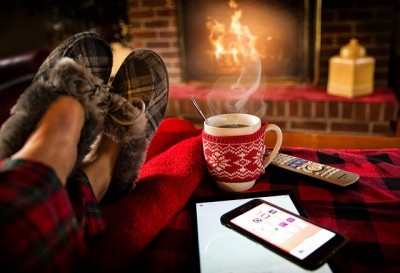A Fireplace Continues to Radiate Heat Even After the Fire is Extinguished

6 Simple Ways To Generate More Heat From Your Fireplace
You may be thrilled to have a fireplace in your home. Your hearth provides an inviting glow and can become the center of a room. However, most masonry fireplaces are designed primarily for decoration and provide little heat. Compared to woodstoves, fireplaces are extremely inefficient: Fireplaces frequently only have 10 percent efficiency, versus 60 percent or more efficiency from a wood stove.
Certainly, it isn't worth your while to chop 100 logs to get 10 logs worth of fuel. If you want to generate heat in your wood-burning fireplace, you are going to need to make some changes. Before doing that, though, ensure you use proper equipment and fireproof materials. Do not install anything in your chimney or fireplace that will endanger your safety during use. If you have any concerns, consult an expert before lighting a fire.
There are a few causes to fireplace inefficiency. First, the heated air is siphoned directly from the house through the chimney flue. Second, while the heated air rushes from the house, it creates negative pressure in the house and contributes to cold air leaking into the house through any other openings. Third, the rush of air over the fire makes the wood burn more quickly. Last, there is little heat reflecting from the fireplace masonry into the room. Fortunately, there are fixes for each of these problems, which you can use separately or together.
1. Use the damper to its potential
If your fireplace is well-designed, it will have a damper you can easily adjust to control the flow of air up the chimney. Once your fire is burning, you can close the flue to allow only a small amount of air through the flue and out of the house. You should close the damper as tightly as possible before smoke comes into the house.
2. Intake air supply from outside
You may be able to modify existing vents to draw in air from outside to feed the fire, thus preventing the vacuum effect of using air from inside the house. This can be a simple modification, depending on the construction of your fireplace, but will not make a large difference in efficiency.
3. Fireback

Image source: Pixabay.com
A fireback is a cast-iron reflector that is placed on the back wall of the fireplace, behind the fire grate. For maximum efficiency, the fireback must be of comparable size to the back of the firebox.
The iron absorbs heat from the fire and reflects it back into the room; it will also store heat after the fire is out and continue to radiate for some time. A fireback will not make a lot of difference on its own, as the heated air still needs to be flowing into the room, but it will help if you are able to control the direction of the airflow.
4. Fireplace doors
Glass or ceramic doors that can be closed once the fire is burning will prevent the flow of air from the room into the fireplace, and allow more air around the fireplace to be heated. It is important to use a glass or ceramic door that can withstand the heat of the fire. Freestanding screens are also available and will serve a similar purpose; ensure they are safely handled to prevent breakage. Fireplace doors also can improve the safety of your fireplace and allow you to attend less to the fire.
5. Heat exchanger
Passive heat exchange systems are simple in principle: The fire rests on a tubular grate that draws cool air from the room and channels it back into the room. Note that these should not be used with glass doors, which may be unable to withstand the heated air venting directly on them. Some heat exchange systems have blowers to aid the convection; ensure yours will not blow sparks or embers into the room.
6. Fireplace with an insert
The best efficiency solution for a fireplace is a full insert. This is essentially installing a wood stove inside the masonry fireplace. The cast iron or iron and steel box should fit securely in the masonry fireplace, and the entire chimney should be lined for maximum efficiency and safety. Fireplace inserts are readily available and will increase the heating potential of your fireplace while reducing the heat loss through the fireplace when not in use.
Regardless of the solution you choose, keep in mind that your first concern is safety. It is better to safely cover your fireplace and not use it than to risk trying a solution that could start a fire. Exercise prudence every time. With a trusted solution for home heating, however, you will soon be enjoying more than a pretty view from your fireplace.
What advice would you add on generating more heat from a fireplace? Share your thoughts in the section below:
aldridgewearprapart.blogspot.com
Source: https://www.offthegridnews.com/how-to-2/fireplace-heat/
0 Response to "A Fireplace Continues to Radiate Heat Even After the Fire is Extinguished"
Post a Comment